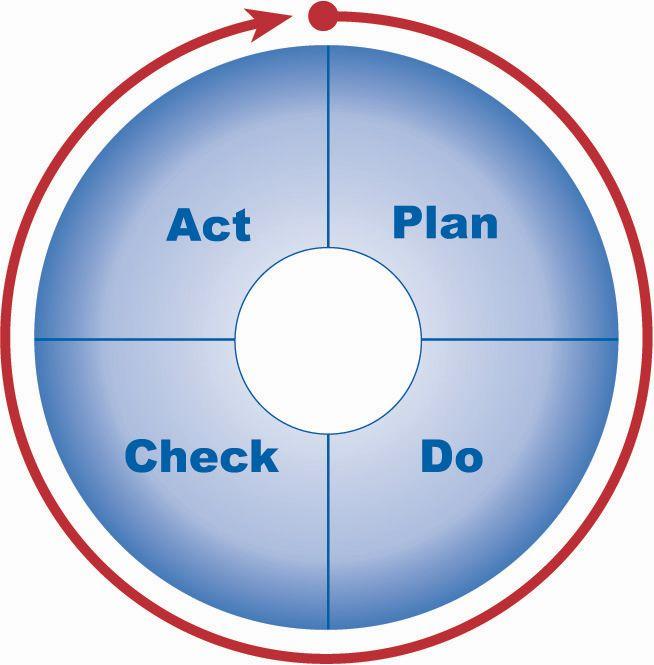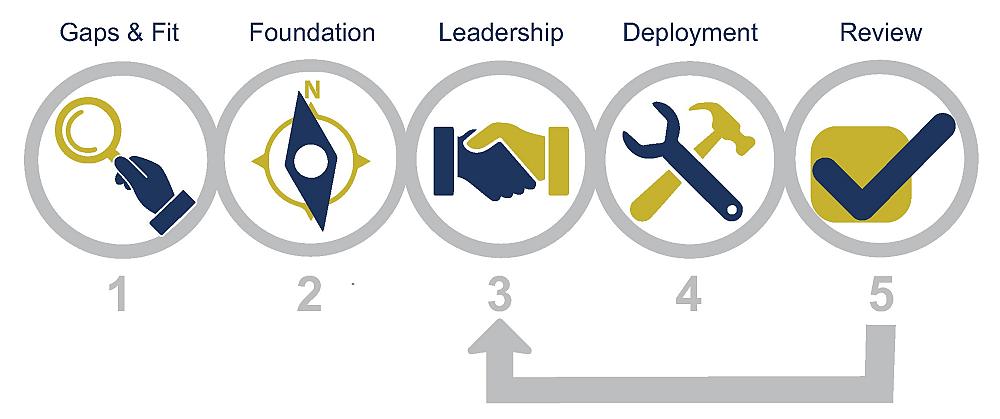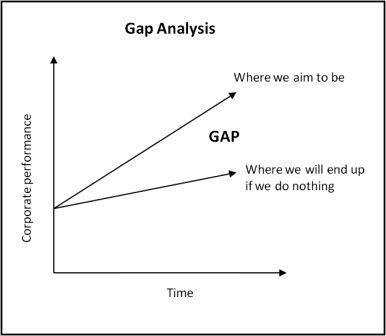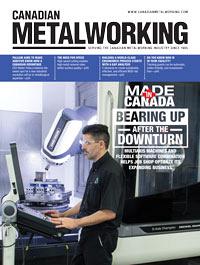- FMA
- The Fabricator
- FABTECH
- Canadian Metalworking
Building a World-class Ergonomics Process Starts with a Gap Analysis
4 elements to create sustainable, effective, and efficient MDS risk management
- By Jeff Sanford and Walt Rostykus
- May 26, 2017
- Article
- Management

Figure 1—Four steps—plan, do, check, and act--comprise the tactical elements of an ergonomics process.
Editor’s Note: This article includes excerpts from the ebook Four Key Elements of an Ergonomics Gap Analysis. The first of a five ebook series is downloadable, at no charge, from www.humantech.com/resources/e-books.
Ergonomics has become a priority in today’s workplace. We talk with business leaders who are concerned with the condition of the tools, furniture, and equipment they provide employees, tasks their employees perform, and the occurrence of work-related strain and musculoskeletal disorder (MSD) injuries. Many companies implement ergonomics programs to prevent of MSD injuries. Some are successful, while others struggle to gain the traction they need to reduce the injuries and their costs. Fortunately, through research and benchmarking studies, we have gathered evidence that organizations successful in managing ergonomics and reducing MSD risk factors create a continuous improvement process, not a program.
This ergonomics process approach applies at a couple of levels: first, when addressing MSD risk in the workplace (the job improvement steps), and second, when managing all elements of the ergonomics process. Both approaches are founded on the Plan-Do-Check-Act continuous improvement cycle (see Figure 1).
The job improvement steps for addressing MSD risks include:
- Plan: Find MSD risk factors in the workplace. Select jobs with high and moderate levels of exposure.
- Do: Make changes to the existing tools, furniture, equipment, and job design that will reduce the level of exposure to MSD risk factors.
- Check: Verify if the changes reduce the level of exposure to an acceptable (low) level.
- Act: Sustain the improvement to control the risk.
These steps are the tactical elements of an ergonomics process, similar to those in an environmental or safety management system. They provide a way to integrate ergonomics into the existing methods used to manage all aspects of a business.
Although most employers are familiar with using the continuous improvement methodology to manage ergonomics at a tactical level, we receive requests from many who struggle with the strategic aspects of establishing an ergonomics process, or transitioning their current ergonomics program into a sustainable, effective, and efficient process.
Companies can establish an ergonomics improvement process using a five-step engagement model (see Figure 2). This approach has proven to be a successful road map and it all starts with a gap analysis. The results provide everyone in an organization with a common understanding of the current situation and enable them to form a common vision for the ergonomics process.
The gap analysis answers these questions:
Gap analysis is a critical step in planning a new ergonomics process or transitioning to a more effective one. It’s a way to assess the difference between the current situation (where you are) and meeting the requirements and expectations of an overarching goal (where you want to be).

CAPTION: Figure 2— An ergonomics gap analysis communicated throughout an organization can provide everyone with a common vision and goal for the ergonomics process.
The results provide everyone in an organization with a common understanding of the current situation and enable them to form a common vision for the ergonomic process. The gap analysis answers these questions:
- What are we not doing, or not doing well (what are the gaps)?
- What are we doing well (the things we can leverage, or the fits)?
- Where do we want to be (vision and goal for ergonomics and MSD injuries)?
We've identified four key elements for a successful gap analysis.
Element 1: Establish the Criteria
The criteria you select depends on your desired results—your goal for the gap analysis (see Figure 3). Is it to improve management of the ergonomics process, meet country regulations, or meet company standards? Or is it a combination of these?
Based on your goal, select and compile the criteria needed. For example, we are most often asked to determine the gaps between a company’s current ergonomics program and a world-class process. So, the criteria should be based on the strategies, features, and elements of successful ergonomics processes. We’ve learned what differentiates these leading companies through a series of benchmarking studies.
As well as having the goal of improving their ergonomics process, many organizations have additional needs, such as complying with country and local regulations; meeting the company ergonomics standard, quality standard, and engineering standard; or adhering to an established safety management system. The key is to tailor the criteria to match your particular goal.
The criteria for a gap analysis should include two general categories: what must be done (standards and regulations) and how best to do it (best practices). Once the criteria are defined, ensure that the right people are using them.
Element 2: Use Capable Evaluators
Evaluators do not necessarily need to have technical knowledge of ergonomics (as do ergonomists, ergonomics team members, and safety professionals), but they do need to be familiar with, and have some knowledge of, the steps required to implement an effective ergonomics, safety, or quality process or some form of process management. In other words, it’s critical to have a process mindset in order to look at the current ergonomics program as a whole.
Conducting a gap analysis is similar to performing an audit, so the evaluator should have the same capabilities and skills as an auditor. An evaluator should be able to:
- Conduct effective interviews.
- Integrate information from multiple sources.
- Be objective.
- Identify gaps.
- Identify opportunities.
Once the right evaluators are selected and prepared, the evaluation can begin.
Element 3: Complete a Comprehensive Evaluation
A comprehensive evaluation is not limited to meeting if the criteria; it also evaluates how well it is performed. Three primary components of an evaluation are:
- Review key documents describing what is planned and what was done.
- Interview key people to gain the varying perspectives throughout the organization on a specific element of the program (metrics, using ergonomic design criteria, funding ergonomic improvements, prioritizing MSD risks, etc.).
- Observe the workplace firsthand to validate the ergonomics controls described in records and during interviews, as well as the risk reduction challenges a site may face.
Element 4: Provide Actionable Direction
Informing the leaders of your organization about the identified gaps and opportunities is a valuable final step. Ultimately, you want to provide clear direction on the action items to take to close the gap. But first you’ll need to provide the “tough love” exercise of sharing your findings (what they are not doing or not doing well).
An effective way to illustrate the gaps is to put the evaluation criteria in table form, with the column headings “Meets Expectations” and “Needs Attention.” Showing the findings mapped to the criteria as a process helps people understand the interactions and sequence of the entire ergonomics process.
Along with the bad news, give good news. Leadership needs to hear what is going well. This could include highlighting a well-managed training program, an effective evaluation process for ensuring accountability, a safety risk assessment method that could be expanded to include MSD risk factors, or a good engineering phase-gate review process that could be expanded to include ergonomic design criteria. The goal here is to find existing systems in the organization that are effective and into which elements of the ergonomics improvement process can be integrated. By “finding a gem,” you identify existing ways to close the gap.
The gap analysis and list of what is/is not done well should provide direction. The gap analysis must do so through recommendations on both the strategies and tactical steps needed to close the gap and get the organization to “where we want to be.” Strategies are high-level changes to the overall approach, such as changing from lagging to leading measures, expanding ownership and involvement to all levels of the organization, or moving from a program to a process based on continuous improvement. To make these high-level changes, you’ll need to provide tactical steps—a list of recommended actions in a specific order. This is the road map that will guide your organization to close the gaps and achieve its goal.
Illustrations courtesy of Humantech.
Walt Rostykus, CPE, CSP, CIH is principal consultant and Jeff Sanford, CPE, is director and ergonomics engineer at Humantech, 734-663-6707, www.humantech.com.
subscribe now


Keep up to date with the latest news, events, and technology for all things metal from our pair of monthly magazines written specifically for Canadian manufacturers!
Start Your Free Subscription- Industry Events
ZEISS Quality Innovation Days 2024
- April 15 - 19, 2024
Tube 2024
- April 15 - 19, 2024
- Düsseldorf, Germany
Lincoln Electric's Large Format 3D Metal Printing Seminar
- April 16 - 17, 2024
- Cleveland, OH
CTMA Economic Uncertainty: Helping You Navigate Windsor Seminar
- April 30, 2024
- Windsor, ON Canada
MME Winnipeg
- April 30, 2024
- Winnipeg, ON Canada





















